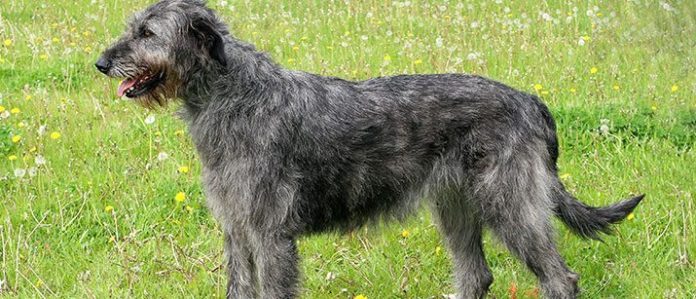The giant Irish Wolfhound has a gentle temperament and a somewhat reserved nature.
Irish Wolfhounds are independent by nature, but bond very closely to their families. They were trained to think independently in their hunting past, rather than relying on close direction. They are gentle with children and incredibly intelligent dogs.
WHAT DOES THE IRISH WOLFHOUND WANT IN THEIR PERFECT LIFE PARTNER/FAMILY?
I would love to live in a family that loves long walks and outdoor life. My ideal family has older kids and has time to spend with me. I love to live with other dogs and also rarely chase cats.
AT A GLANCE
| Lifespan | 6-10 years |
| Weight | 40-70 kg (88-155 lb) |
| Height (at shoulder) | 71-90 cm (28-35 in) |
PERSONALITY
Gentle – this gentle breed loves to cuddle up on the couch and be with the family. They are lovable, sweet and kind and despite their enormous size they would never (deliberately) hurt a fly.
Intelligent – These intelligent dogs are very trainable and need at least 2 hours a day of exercise and training when young and continuing on into adult-hood. Without mental stimulation and training they become easily bored and sometimes destructive.
Loyal – this breed will often bond very closely to one person in the family and be extremely loyal. This can translate to a dog that is not suited to long periods of being alone and perhaps even a bit snappy if not socialised appropriately.
EXERCISE & TRAINING
| Exercise Requirements | Medium – 0.5-1.0 hours per day |
| Training Requirements | Medium – 0.5-1.0 hours per day |
| Apartment Friendly? | No |
Although these are larger dogs, they don’t need more exercise than a small breed dog. They do need daily walks and firm training to ensure they are happy and easy to live with.
GROOMING
| Trips to the Groomer | No- easy care at home | |
| Tick Friendly? | Yes | |
| Hypoallergenic | No | |
| Brushing | Medium – Weekly brushing required | |
| Hair fall | Moderate Shed – will drop some hair, but not excessive | |
| Coat Type | Medium |
The wiry coat of the Wolfhound is low maintenance, so no need for excessive brushing. They can be smelly dogs and difficult to bathe due to their size, though a mobile dog groomer can help with this feat.
FAMILY SITUATION
| Good With Kids | Good – okay with older kids, but maybe not those under 5 | |
| Good With Other Small Pets | Medium – Ok with other pets, supervision advised | |
| Sociability | High – Loves other dogs and best in a multi-dog household. |
The Wolfhound is a gentle, loving family pet, but should be supervised around younger children simply due to its size. Unlike many hunting dogs, Wolfhounds can often be suited to cats with households, but they should be supervised around smaller pets. They are sociable animals who don’t like to be left alone, so consider two dogs.
EXPENSES
| Overall Expenses (Annual) | High $2000+ | |
| Veterinary Expenses (Annual) | High – $300-$500+ | |
| Food Expenses (Weekly) | High – $20-$30+ |
The Wolfhound can be an expensive dog to own in its comparatively short life. Food and veterinary bills are often high simply due to size.
HEALTH & WELLBEING
MAJOR HEALTH CONCERNS
Bloat and Gastric Volvulus: Large deep-chested breeds are prone to bloat, which is where the stomach rapidly expands with gas and fluid. Bloat can often then lead to torsion or twisting of the stomach, which is rapidly fatal if not treated immediately.
Hip Displaysia – Many breeds are prone to hip dysplasia, and while more breeders are hip scoring in an attempt to breed out this devastating disease, in some cases it can still occur, particularly with overfeeding at a young age.
DCM – Dilated Cardiomyopathy can occur in large breed dogs. This enlargement of the heart can progress to heart failure, weakness and collapse.
Bone cancer – Irish Wolfhounds have a higher prevalence than many breeds of developing cancer, particularly bone cancer. If your Wolfhound has any form of lameness, please get it checked early.
PREVENTATIVE CARE & WHAT TO LOOK FOR:
Avoid overfeeding or over exercising your Wolfhound when growing to reduce the risk of hip dysplasia.
Feeding two smaller meals a day and avoiding exercise within an hour of eating can reduce the chance of bloat and torsion.
Ask your vet to regularly check your dogs heart for signs of DCM or heart disease.
BREED ORIGIN AND INTERESTING FACTS
The Irish Wolfhound is on average taller than the Great Dane, but with a slimmer build. The world record for tallest dog has usually been a Great Dane not a Wolfhound, however.
It is thought that Wolfhounds were brought to Ireland in 7000BC.
Wolfhounds were bred in Ireland as hunters (mainly for wolves) and also guarded homes, stock and their children. Today they often make terrible guard dogs due to their gentle nature.
Wolfhounds were often owned exclusively by royalty and during AD600-900 the numbers you could own depended on your status.
During the 18th Century their numbers had declined so much that the breed almost completely died out. Deerhounds and a few other breeds were incorporated to increase numbers again.
RESCUE AN IRISH WOLFHOUND
Petfinder lists all types of dogs who need homes, both purebred and mixed breeds, adults and puppies.
The ASPCA often has Irish Wolfhounds for adoption, just do an advanced search on their adoption page.









